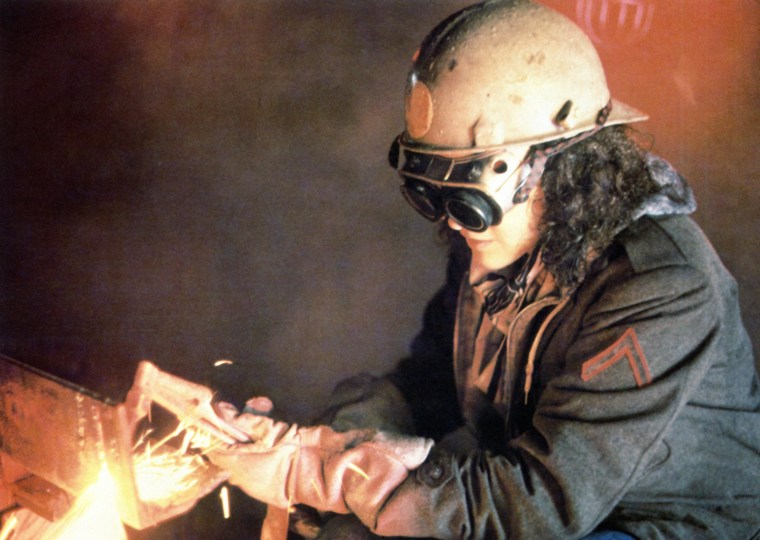Six years after the start of a deep recession and a growing call for more middle-class manufacturing jobs, one American industry is tackling workforce development in a unique way. Welding is courting fresh recruits—women in particular.
Mention women welders and "Flashdance" might come to mind. The 1983 movie starred Jennifer Beals as a welder by day and dancer by night. But the industry has advanced beyond the bulky machinery depicted in the film.

Modern welding techniques are highly specialized and can include automation. Shop floors are brighter and cleaner. Welders work on specialized structures for the marine and aerospace sectors, even on custom cars for reality TV shows.
Despite cool projects, available work is outpacing qualified tradespeople—largely due to an aging workforce.
Welding groups aren't recruiting women at the exclusion of men. Instead, they're reaching out to everyone—including a targeted push at women.
"Any metal shop you talk to, they're desperate for good metal fabricators," said Scott Behr, owner of Total Metal Resource, based in Brooklyn, N.Y. Their work includes metal staircases and signage for the Colicchio & Sons restaurant and Chobani yogurt shop, both in Manhattan.
Welding is fighting the notion that it's old-fashioned. Few younger people are choosing welding and related fields as careers. When 18- to 24-year-olds recently were asked what industry they preferred, manufacturing ranked fifth among seven industries. Technology came in first, with retail at seventh, according to the Manufacturing Institute in Washington, D.C.
And while technology is ever-present in academics, schools have scaled back on shops and vocational training. The value of making something with your hands has taken a back seat to pursuing four-year degrees.
"Since there's a shortage of skilled workers and the pay is good, welding is a marvelous opportunity for young women."
That’s now haunting manufacturing. Not only are welders older with few younger apprentices, key sectors like oil and gas, which require extensive pipe welding, is booming. Adding to the shortage in welders is reshoring—or the return of lost manufacturing to the U.S. that may require welding.
The average American welder is 54-years-old, and about 45 percent of the workforce is in their 50s or older, said Monica Parr, corporate director of workforce development at the Miami-based American Welding Society. The U.S. economy includes more than 388,000 welding jobs. The welding society projects the need for 111,000 new welders in five years as industry needs grow and some workers retire.
There are few women in the field: only 3 percent of U.S. professional welders are women.
"Since there's a shortage of skilled workers and the pay is good, welding is a marvelous opportunity for young women," said Nancy Cole, last year's welding society president. Only the second female president in the group's 95-year history, Cole traveled to some 26 states and 13 countries in 2013 to stump for manufacturing and welding.
Hourly wages with basic certification can start around $15—double the $7.25 federal minimum wage. Hourly wages can climb to $25 with more experience, said Judith Crocker, who leads talent development at the Manufacturing Advocacy & Growth Network in Cleveland.
Cole and others are reaching out to community colleges to emphasize opportunities as engineers, welders and technicians. Recruiters also are collaborating with high school counselors, who generally get "kudos" for students they send to four-year colleges—not trade schools, Cole said. "So you have to overcome that as well," she said.
When Maryland-based welder Becky Lorenz, 59, was attending high school during the late '60s, no one from manufacturing was wooing her. She had to petition school officials to take the boys-only shop classes.
There was concern about the safety of girls—running around shop class in skirts and dresses, not blue jeans, she recalled. But ever since Lorenz's dad had bought her a brass, Craftsman welding torch at a farm auction, it was love at first bead. Lorenz wrangled her way into the school shop. She pocketed awards at the Montgomery County Fair for small bird sculptures, crafted from horse shoe nails. Lorenz was on her way to a career as a welder and machinist.
Decades ago, welding shops indeed were dangerous, dark and filled with large equipment. But shops are safer, brighter and smoking-free. Women don't need to lift 50 pounds: Robotic equipment can help. "Parents wanted their kids to have an easier life," Cole said. "Now shops look like you could literally eat off the floor."
Modern welding still is demanding. You can be sweating inside a shop or shivering in the cold outside working on-site. But no two jobs are alike. And being a petite female welder has its advantages. At 5-foot-2, Lorenz is able to squeeze into confined spaces. "It's crazy," said Lorenz, whose resume includes work for the University of Maryland physics department and the NASA Goddard Space Flight Center.
When Lorenz isn't busy making something, she's recruiting the next generation. She's looking for young upstarts like Charron Wynn, 28, who is studying applied sciences, including welding at Lorain County Community College in Elyria, Ohio. She was exposed to more traditional fields, including accounting and nursing, but she kept returning to working with her hands—arts and crafts, sewing—before finding welding. "I picked it up and I haven't been able to put it down," she said.
But the industry needs more Wynns. Shortages in skilled production jobs are hurting manufacturers' ability to expand, drive innovation and boost productivity, according to a Manufacturing Institute skills gap report from 2011, the latest year of data available.